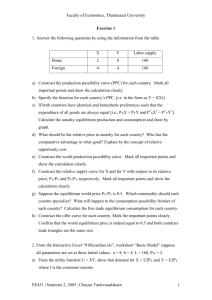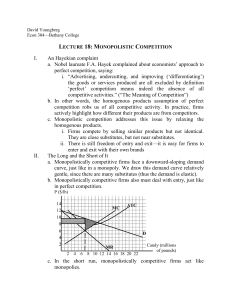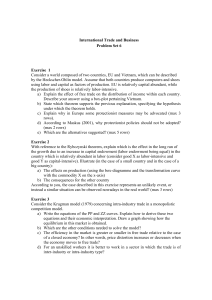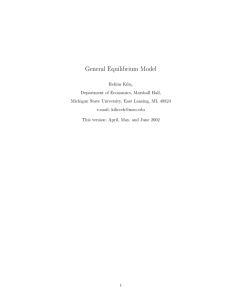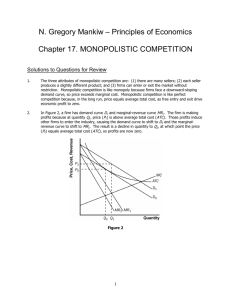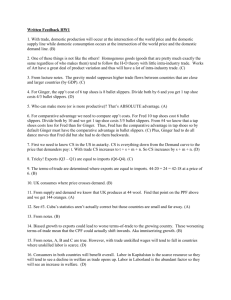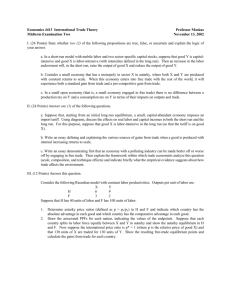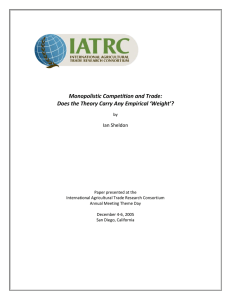Trade Under Increasing Returns to Scale
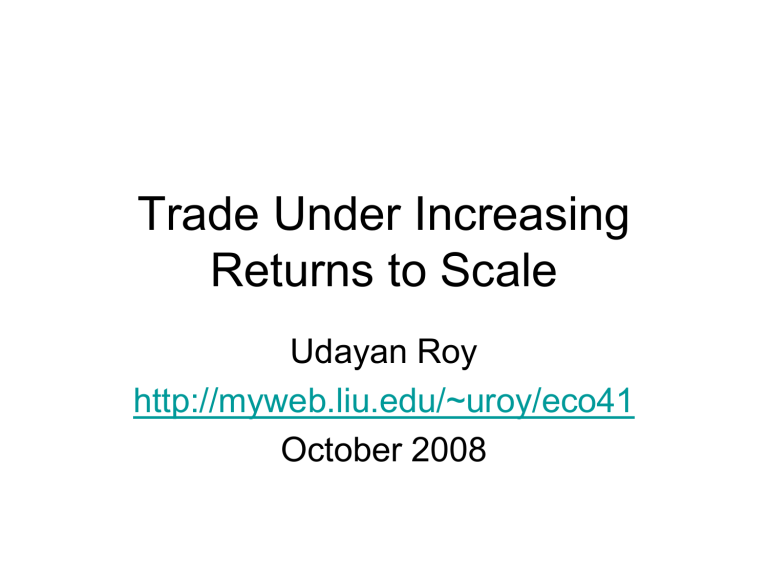
Trade Under Increasing
Returns to Scale
Udayan Roy http://myweb.liu.edu/~uroy/eco41
October 2008
Increasing returns to scale
• The Ricardian and Heckscher-Ohlin theories both assume that the technology for the production of a good is characterized by constant returns to scale
• In the 1970s, economists built formal theories of trade that instead assumed increasing returns to scale
Increasing returns to scale
• Under increasing returns to scale, if quantities employed of all resources are, say, quadrupled, then the quantities produced will more than quadruple
• Therefore, when resource costs, say, quadruple, output will more than quadruple
• Therefore, cost per unit produced—also called average cost —decreases as output increases
Increasing returns to scale
• The technology for the production of a commodity is said to show increasing returns to scale if a doubling of the resources used in production causes production to more than double
• This implies that the per unit cost of production will be lower when 20 units are produced than when 10 units are produced
• In other words, increasing returns to scale means that bulk production is cheaper production
Fig. 6-2: Average Versus Marginal Cost
When AC decreases as output increases, MC < AC at all levels of output.
Increasing returns to scale cannot coexist with perfect competition
Price
P = MC < AC implies that no firm can be profitable under perfect competition.
Average cost price
Loss
0
Q
Average cost
Marginal cost
Demand
Quantity
Monopolistic Competition
• We have assumed increasing returns to scale
• Increasing returns to scale cannot coexist with perfect competition
• Therefore, we must assume imperfect competition
Monopolistic Competition
• Specifically, we assume that
– there is one differentiated good
– The industry has many firms
– each firm produces a unique variety of the differentiated good
• We assume that this industry is characterized by monopolistic competition , which is an important form of imperfect competition
Monopolistic Competition
• Under monopolistic competition,
1. Each firm in an industry can differentiate its product from the products of its competitors.
• Each firm sells a product that is somewhat unique
• Each firm faces a downward sloping demand curve
2. Each firm ignores the impact that changes in its price will have on the prices that competitors set
• even though each firm faces competition it behaves as if it were a monopolist.
Monopolistic Competition (cont.)
• A firm in a monopolistically competitive industry is expected:
– to sell more as total sales in the industry increase and as prices charged by rivals increase.
– to sell less as the number of firms in the industry decreases and as its price increases.
• Each firm’s demand curve becomes more elastic
(flatter) as the number of competitors (firms in the same industry) increases
12
Typical firm’s production and
17
20 pricing
Profit per unit = 5
Average Cost
Demand
• This diagram proves that whenever a firm’s demand curve touches its average cost curve at more than one point, the firm will surely enjoy positive profits
• This will induce the entry of competitors,
• Which will reduce the firm’s demand
Quantity
Typical firm’s production and
P = AC =14
15 pricing
D
2
Average Cost
D
1
Quantity
• The entry of competitors will continue to reduce the firm’s demand till demand is tangent to the average cost curve and positive profits are no longer possible
• The entry of competitors will also make demand flatter
Typical firm’s production and pricing —autarky
• Let the autarky outcome be as shown
• How will free trade be different?
14
15
A , Country A’s Autarky
Average Cost
D autarky
Quantity
Free trade
• Under free trade, every firm, irrespective of which country it is located in, will have the same number of competitors
• Therefore, every firm’s demand will be just as flat as every other firm’s demand
• As each firm’s demand must be tangent to its average cost (AC) curve in equilibrium, and as all firms have the same AC curve,
• Under free trade, every firm, irrespective of which country it is located in, will be on the same point on its AC curve
• The question is, Which point will it be?
Typical firm’s production and pricing —free trade
14
B
15
A
• Under free trade, the typical firm’s production and price could be
– At A , or
– At a point such as B , or
– At a point such as C .
• Recall that the demand curve must be tangent to the AC curve in equilibrium
C
Average Cost
D
A
Quantity
Free trade increases market size —assumption
• It is reasonable to assume that total industry output worldwide will be higher under free trade than under autarky in just one country
– Total industry output = typical firm’s output number of firms in the industry
Typical firm’s production and pricing —free trade
14
B
15
A
C
D autarky
• Under free trade, the production and price for a typical firm could be
– At A , Country
A’s autarky outcome, or
Average Cost
– At a point such as B , or
– At a point such as C .
Quantity
Typical firm’s production and pricing —free trade
B
• Could the typical firm’s production and price under free trade be at A ?
• If so, the number of firms would have to increase
– because we have assumed that industry output is higher under free trade
• But in that case the typical firm’s demand would have to be flatter than in autarky
• Therefore, the demand curve could not be tangent to the AC curve at Country A’s autarky outcome, as is required for equilibrium
• In short, for the typical firm, the free trade and autarky outcomes could not possibly be identical
14
A , Autarky = Free Trade outcome?
C
Average Cost
D autarky
Quantity 15
Typical firm’s production and pricing —free trade
B = Free Trade outcome?
• Could the typical firm’s production and price under free trade be point B ?
• Again, the number of firms in the industry would have to increase
– because we have assumed that industry output is higher under free trade
• But in that case the typical firm’s demand would have to be flatter than in autarky
• Therefore, the demand curve could not be tangent to the AC curve at point B , as is required for equilibrium
• In short, for the typical firm, the free trade outcomes could not be a point such as B
•
Therefore, the free trade outcome would have to be a point such as C.
A , Autarky
C 14
Average Cost
D autarky
Quantity 15
Typical firm’s production and pricing —free trade
• The free trade outcome would have to be a point such as C .
• That is, free trade output is higher than autarky output for the typical firm as well as the industry
• And the price is lower in free trade
B
14
15
Autarky
C = Free Trade outcome
Average Cost
D autarky
Quantity
Trade Leads to Specialization
• IRS means that large-scale production is cheaper than small-scale production.
Therefore,
• Trade under IRS generally has one country specializing in the production of one good and the other country specializing in the production of the other good.
Trade = Greater Variety
• In autarky, a country would be able to produce only a few brands of, for instance, cars, because if many brands are produced in autarky, each brand would have to be produced in small-scale and that would usually be very expensive.
• Under free trade, on the other hand, each country can bulk produce just a few brands for customers all over the world and, in this way, more brands of cars would be available to consumers everywhere at prices they can afford
Similarity = Trade
• Even identical countries may trade
• This could happen simply because their technologies may have increasing returns to scale (IRS)
Monopolistic
Competition and Trade
• As a result of trade, the number of firms in a new international industry is predicted to increase relative to each national market.
– But it is unclear if firms will locate in the domestic country or foreign countries.
Inter-industry Trade
• According to the Heckscher-Ohlin model or Ricardian model, countries specialize in production.
– Trade occurs only between industries: inter-industry trade
• In a Heckscher-Ohlin model suppose that:
– The capital abundant domestic economy specializes in the production of capital intensive cloth, which is imported by the foreign economy.
– The labor abundant foreign economy specializes in the production of labor intensive food, which is imported by the domestic economy.
Fig. 6-6: Trade in a World Without
Increasing Returns
Intra-industry Trade
• Suppose now that the global cloth industry is described by the monopolistic competition model.
• Because of product differentiation, suppose that each country produces different types of cloth.
• Because of economies of scale, large markets are desirable: the foreign country exports some cloth and the domestic country exports some cloth.
– Trade occurs within the cloth industry: intra-industry trade
Intra-industry Trade (cont.)
• If domestic country is capital abundant, it still has a comparative advantage in cloth.
– It should therefore export more cloth than it imports.
• Suppose that the trade in the food industry continues to be determined by comparative advantage.
Fig. 6-7: Trade with Increasing Returns and
Monopolistic Competition
Inter-industry and Intra-industry
Trade
1. Gains from inter-industry trade reflect comparative advantage.
2. Gains from intra-industry trade reflect economies of scale (lower costs) and wider consumer choices.
3. The monopolistic competition model does not predict in which country firms locate, but a comparative advantage in producing the differentiated good will likely cause a country to export more of that good than it imports.
Inter-industry and
Intra-industry Trade (cont.)
4. The relative importance of intra-industry trade depends on how similar countries are.
– Countries with similar relative amounts of factors of production are predicted to have intra-industry trade .
– Countries with different relative amounts of factors of production are predicted to have inter-industry trade .
5. Unlike inter-industry trade in the Heckscher-Ohlin model, income distribution effects are not predicted to occur with intra-industry trade.
Inter-industry and
Intra-industry Trade (cont.)
• About 25% of world trade is intra-industry trade according to standard industrial classifications.
– But some industries have more intra-industry trade than others: those industries requiring relatively large amounts of skilled labor, technology, and physical capital exhibit intra-industry trade for the U.S.
– Countries with similar relative amounts of skilled labor, technology, and physical capital engage in a large amount of intra-industry trade with the U.S.
